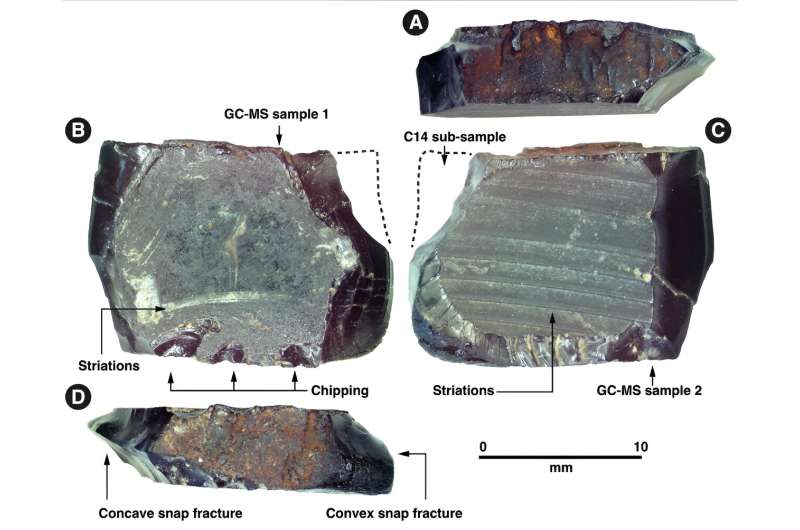"Ancient Resin Artifacts Reveal Earliest Evidence of Human Migration Across the Pacific"

August 20, 2024 feature
This article has been reviewed according to Science X's editorial process and policies. Editors have highlighted the following attributes while ensuring the content's credibility:
- fact-checked
- peer-reviewed publication
- trusted source
- proofread
by Sandee Oster , Phys.org
Exactly when and how humans dispersed into and through the Pacific remains an intensely debated topic. Previous studies have been hampered by imprecise chronometric dating, making the exact timing and movement of people into the Pacific difficult to ascertain.
One of the earliest sites humans have occupied in northern Australia is the Madjedbebe rock shelter, dated to about 65–60 thousand years ago (ka). In order to reach this area, Homo sapiens would have had to travel through the Wallacea Islands to reach Sahul, the Pleistocene continent that connected New Guinea and Australia. However, sites along this southern route only have evidence of human occupation dating to around 44ka.
These discrepancies in the data have led to some archaeologists arguing that the northern Australian dates are erroneous and that humans likely only arrived in Sahul much later, after 50 ka.
A recent publication by archaeologist Dr. Dylan Gaffney and a team of international researchers, published in Antiquity, has provided the earliest known evidence of humans arriving in the Pacific to more than 50ka.
The discovery, in the form of a tree resin artifact from Mololo Cave on Waigeo Island, dates to about 55–50ka. Made by cutting into a tree and eventually extracting the hardened sap, it provides insights into when and how Homo sapiens may have migrated through these islands, the routes they took and how they adapted to the new challenges and opportunities around them.
The method of extraction is similar to how ethnographic accounts describe how the Waigeo people extracted tree resin. What the resin may have been used for is unknown. However, tree resin is multifunctional and could have been used to fuel fires, construct boats or in the hafting of stone tools.
According to Dr. Gaffney, 'The resin from Molokai demonstrates sophisticated technological processes innovated by people moving into rainforest environments (where the resin trees are found). This adds to our growing understanding of the adaptability and flexibility of early human forager groups in the Pleistocene.'
Homo sapiens likely reached the island by watercraft, ca. 50ka, when the distance between Waitata and Sahul was, on average, 5–6 km or only 2.5 km wide at its narrowest.
This was determined using seafaring models, says Dr. Gaffney. 'We used computer simulations of Pleistocene sea currents to model how long it would have taken to get between these islands. We found that there would have been a high rate of success for seafarers wanting to cross these water gaps, and skilled seafarers would have done this relatively easily.'
In addition to the tree resin artifacts, other artifacts provide insights into the adaptive strategies and capabilities of these early humans. The fauna accumulated in the cave is a mix of natural and human-accumulated remains, indicating humans were skilled hunters able to exploit the fauna in these forested tropical environments.
'Some bones in the deposit are likely natural, including smaller animals like small rodents and microbats. The other larger animals like terrestrial birds, marsupials and megabats are more likely to result from human predation,' said Dr. Gaffney.
Additionally, some marine remains, including the teeth of fast-swimming carnivorous fish and sea urchins, were recovered. These would have been sourced from the coast, located about 15 km away and brought to the cave for further processing.
These findings contribute to the current understanding of the human dietary breadth and show that humans traveling along the northern route did not restrict their diets to marine resources, unlike what has been argued for the southern route.
Additionally, some lithic artifacts have been recovered from Mololo, although, other than a potential core, none date to the Late Pleistocene around the time when the tree resin artifact was found. The sparseness of lithic artifacts is characteristic of sites in the north-eastern Wallacea and north-western New Guinea where many tools would have been made of organic material instead.
Although sparse, the Mololo cave investigations provide crucial insights into occupation along the northern route to Sahul. The assemblage from Mololo was most likely made by Homo sapiens. However, it is possible, based on modern population genetics, that individuals with Denisovan and Homo sapien ancestors may have been the ones migrating along this northern route.
Further research is necessary to gain a comprehensive understanding of the movement and timing of human populations, not only at Mololo.
Dr. Gaffney stated, 'We are currently conducting additional research in the Raja Ampat islands. Despite the difficulties of working in these rainforest environments, there is significant potential to greatly enhance our knowledge of the human history in this region.'
More information: Dylan Gaffney et al, Human dispersal and plant processing in the Pacific 55,000–50,000 years ago, Antiquity (2024). DOI: 10.15184/aqy.2024.83
Journal information: Antiquity
© 2024 Science X Network




